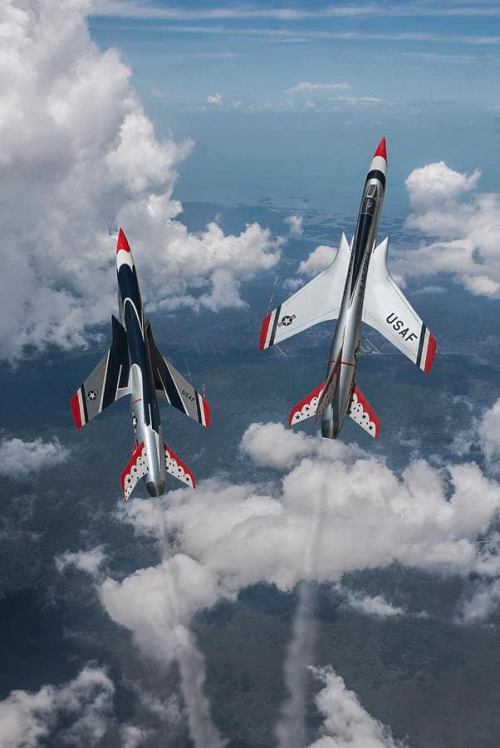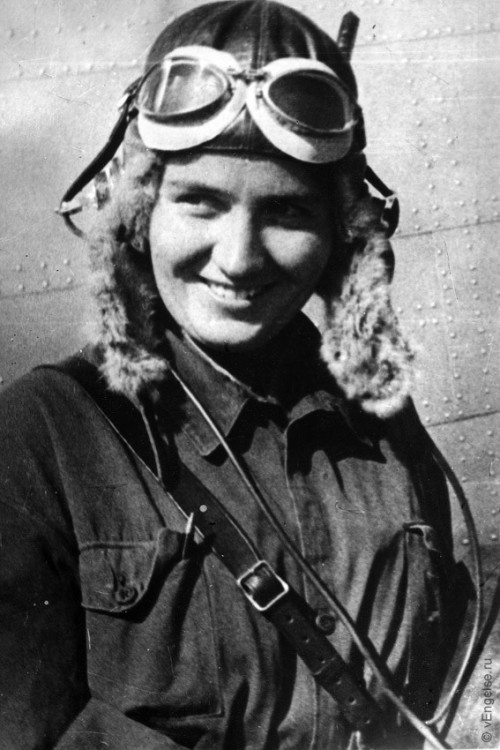#bombers
In 1964, the team transitioned to the supersonic fighter-bomber, the F-105B Thunderchief.
The F-105 was one of the primary attack aircraft of the Vietnam War with over 20,000 sorties flown and was known for it’s high speed and low-altitude attack capabilities.
Although it was a smaller aircraft, the single-engine fighter-bomber could deliver a larger payload than the largest bomber platforms from World War II, like the B-17 Flying Fortress.
Post link
Marina Raskova (1912-1943) was a Soviet pilot, navigator, and commander who founded 3 famous female air regiments during the Second World War.
Born to a middle-class Russian family, Raskova initially had aspirations of becoming a musician, but eventually abandoned the idea to study chemistry. While working in a dye factory as a chemist she met Sergei Raskov, an engineer, who she married and had a daughter with. She changed careers in 1931 when she joined the Aerodynamic Navigation Lab of the Soviet Air Force as a draftswoman. Aged 19 in 1933 she became the first female navigator in the Air Force and the following year became the first woman to teach at the Zhukovskii Air Academy.
In 1935 she divorced from her husband and focused on her flying career. She become a famous pilot as well as a navigator, setting a number of long distance records. This included the famous ‘Flight of the Rodina’ covering 6000km from MoscowtoKomsomolsk, which she conducted with two other female pilots, Polina OsipenkoandValentina Grizodubova. However the flight ran into difficulties at the end of its 26 and a half hour journey when poor visibility hampered the landing. As the navigator’s pit was vulnerable in crash landings, Raskova bailed out with a parachute while the two pilots completed the landing. She survived with no water and almost no food for 10 days before she found her way to landing site and reunited with her team. All 3 women were decorated with the ‘Hero of the Soviet Union’ award, the first women ever to receive it.
With the outbreak of World War 2 the Soviet Union was in need of pilots and many women volunteered. However while there were no formal restrictions on Soviet women in the military, many found their applications were denied or mysteriously delayed. Raskova proposed the creation of women’s aviation units and used her celebrity status to propose the idea directly to the Soviet leader Joseph Stalin. Following a speech by Raskova in September 1941 calling for women pilots to be welcomed into the war, Stalin ordered the creation of 3 new air regiments, the 586th Fighter Aviation Regiment, the 125th Guards Bomber Aviation Regiment, and the 46th Taman Guards Night Bomber Aviation Regiment, dubbed The Night Witches. These regiments were entirely formed of women, from the pilots to the engineers to the support staff. Each regiment contained around 400 women, most of them in their early twenties, who completed 4 years’ worth of training in a matter of months.
Raskova personally took command of the 125th Bomber Regiment, for which she obtained the very best equipment available, including the state-of-the-art Petlyakov Pe-2 bombers, which caused some resentment from male units. The 125th regiment went on to fly 134 missions over the course of the war, dropping over 980 tons of bombs.
Raskova herself was killed on January 4th 1943, while attempting to lead two other Pe-2’s to a safe airfield. She was forced into making a forced landing on the Volga Bank, which resulted in the deaths of the entire bomber crew. Raskova received the first state funeral of the war and her ashes were buried in the Kremlin Wall beside those of fellow pilot, Polina Osipenko. She was posthumously awarded the Order of Patriotic War 1st Class and the regiments she created continued to serve for the duration of the war.
Post link

WC-54 ambulances waiting for returning B-24 Liberator bombers of the 453rd Bomb Group at Old Buckenham in England, March 16, 1944.
Onlyfans.com/SmokingAlphaGermany
Keep smoking hard!
“Bombing our enemies from seven miles up involves many problems you’d never dream of” (1944)
Post link




